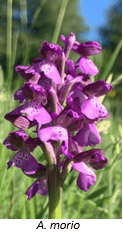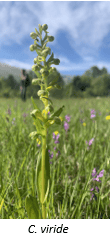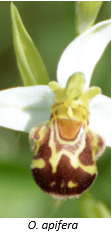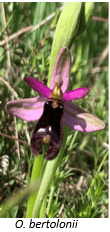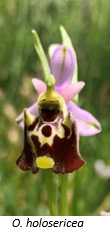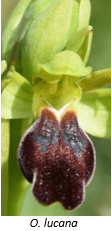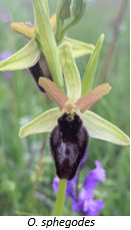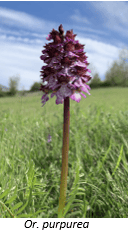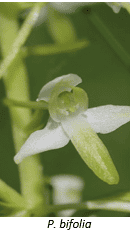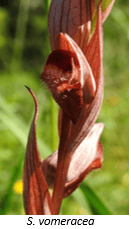PONTE SARRIGONE:
The vegetation at this site is not very different from that described for the Cotte locality, to which is added the presence of patches of hygrophilous vegetation at the stream. The element that characterizes these formations is the white willow (Salix alba), to which are added elder (Sambucus nigra) and in some cases also aspen (Populus tremula).

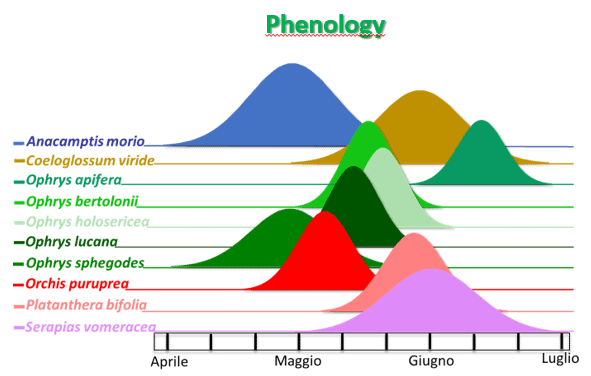
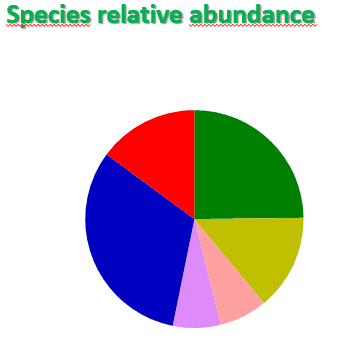
Description of the species
Anacamptis morio
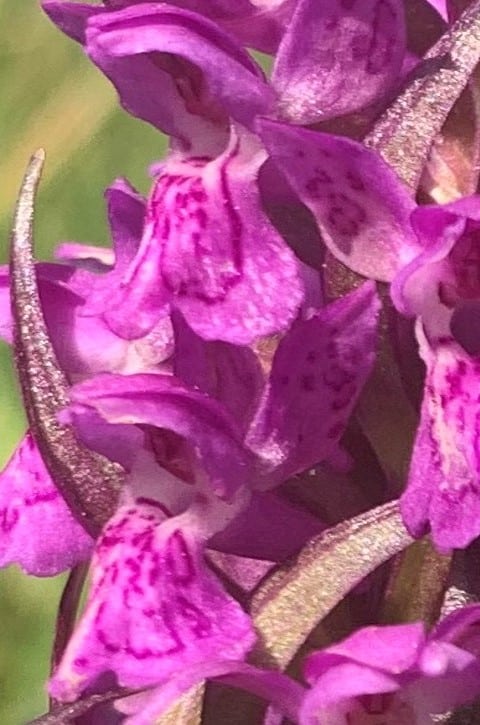
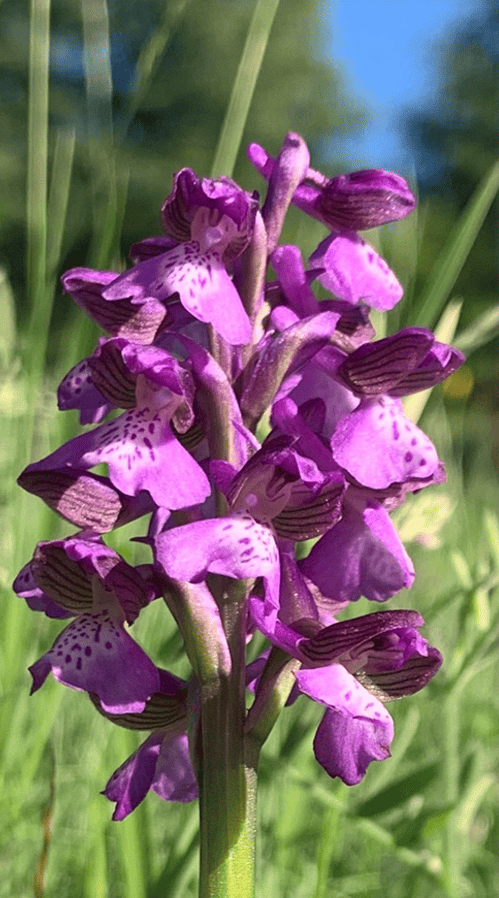
Anacamptis morio
Etymology: the origin of the specific epithet is currently unclear. The term morio may derive from the latin morio-onis (clown), because of the spotted flowers resembling the clothes of a clown, or morrion from the Spanish (helmet) because of the way the tepals are arranged.
Description: a medium perennial up to 35 cm in height. The scape, ranges from green to purplish. The lower leaves are lanceolate and arranged in a basal rosette, while the upper leaves wrap around the scape. The inflorescence consists of 5 to 25 flowers. The flowers are purple in colour; white flowers are not uncommon. The tepals are almost always streaked with green. Lip bluntly 3-lobed and almost folded in 2, the edge is crenulated, the central part paler than the margins characterized by many small purple maculae. Pollinated mainly by bees.
Coeloglossum viride
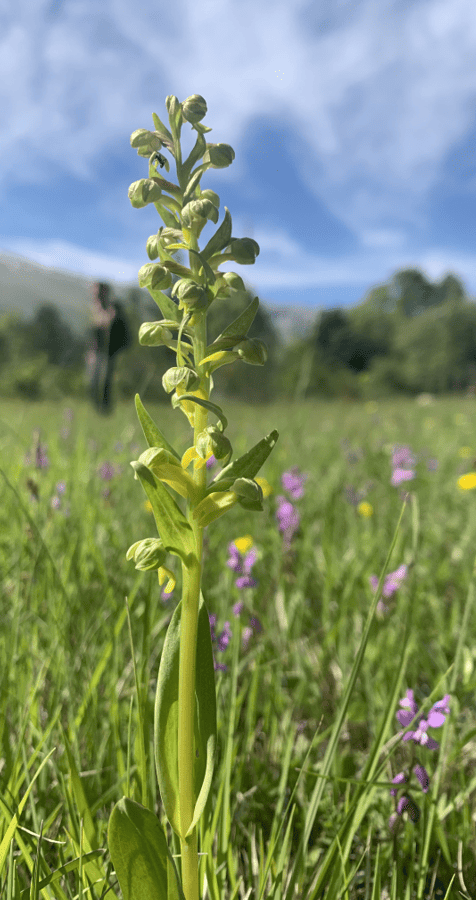
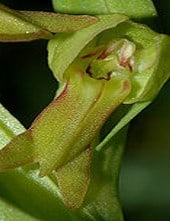
Coeloglossum viride
Etymology: Coeloglossum derives from the greek Koilos-glossa (from the hollow tongue) and viride from the latin viridis (green) due to the green colour of the flowers.
Description: plant up to 35 cm high. Green, grooved stem. The lower leaves are ovate while the upper leaves are lanceolate and acute. The inflorescence is loose with up to 25 flowers. The flowers are light green, and the sepals and petals are grouped to form a helmet around the lip.
The lip is pendulous, tongue-shaped, 3-lobed, and green with brownish-red shaded margins. The lateral lobes are longer than the median and are slightly bent forward. Spur small, sac-like and nectariferous. Gynostemium small and pollen diverging downwards.
Ophrys apifera
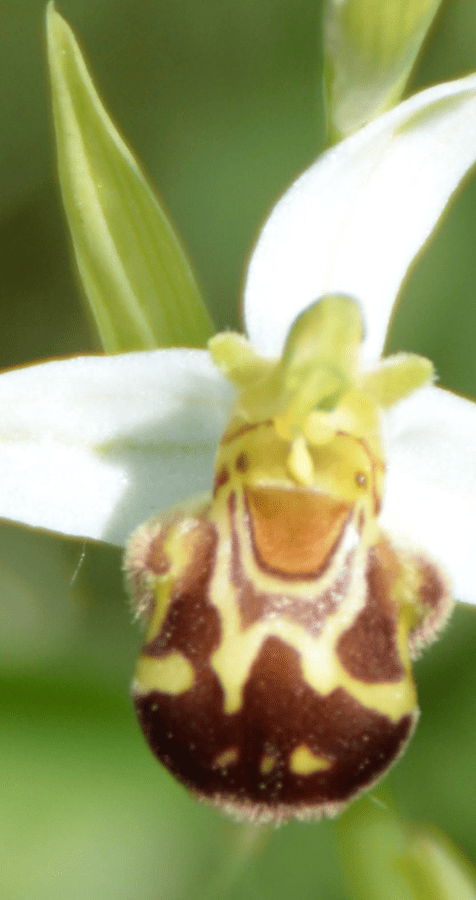
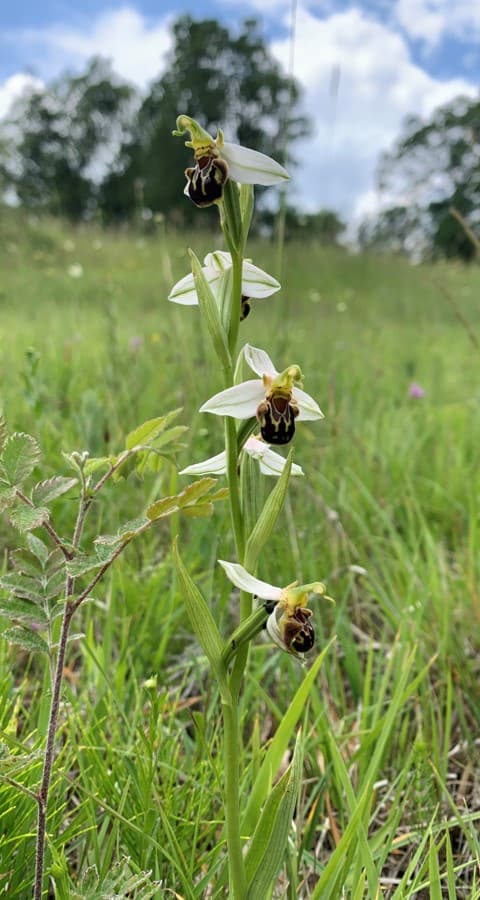
Ophrys apifera
Etymology: The term apifera derives from the latin apis and fero (bee-bearer) due to the resemblance of the flower to the bee.
Description: plant up to 60 cm high. Scape robust, light green, light green leaves clustered in a basal rosette. Inflorescence lax with 2 to 10 flowers. Flowers are relatively large with sepals of various colours from white to pink, with a green centre rib. Petals are very small, green, and triangular. The lip is velvety 3-lobed brown, with small, hairy lateral lobes. The median lobe is round and has a poorly articulated speculum, bordered by a very thick yellow line. Acute rostrum gynostemium with the typical shape of an S.
Ophrys bertolonii
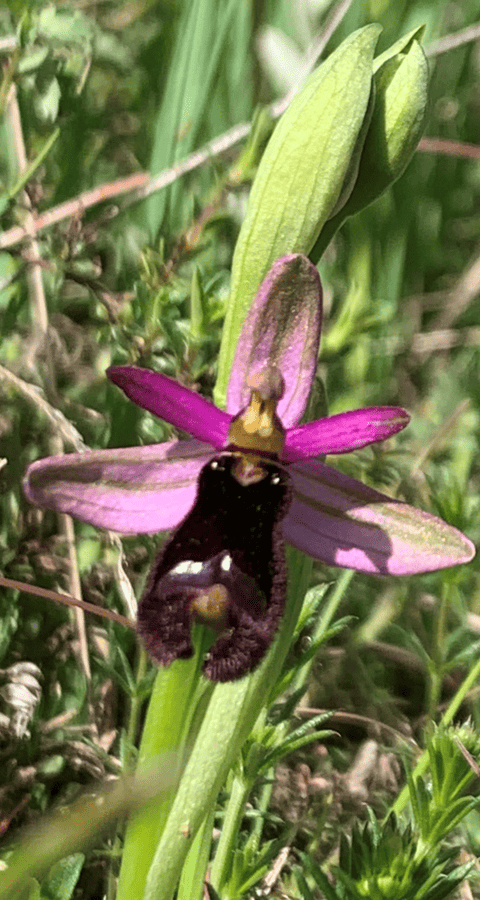
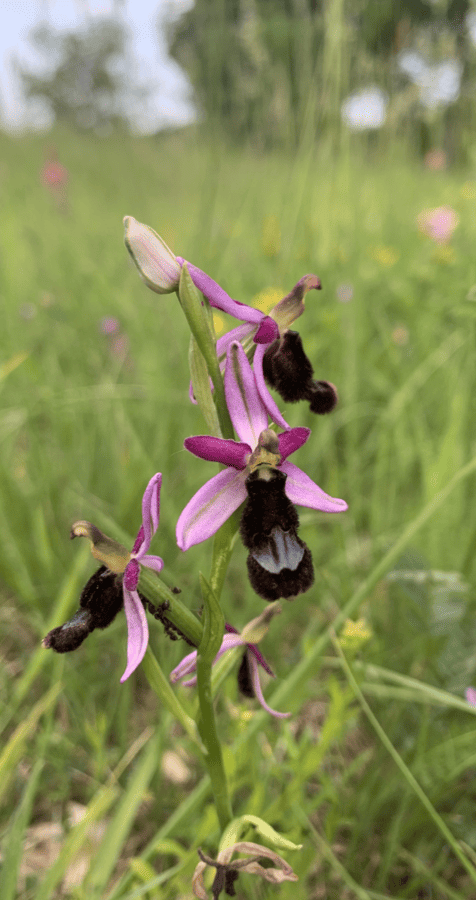
Ophrys bertolonii
Etymology: the name was given to honour the famous botanist, Antonio Bertoloni.
Description: a plant up to 90 cm high. Stem green and slender. Leaves arranged in a basal rosette. The inflorescence consists of 2 to 8 large flowers. The sepals are pink, while the tepals are a deeper pink than the sepals and are sometimes purple. The entire, black labellum has the typical saddle shape covered with reddish-brown hairs on the margins. At the base of the labellum, there is a shiny shield-shaped speculum of a blue-red colour. The apicle is very large and green to yellow in colour, facing upwards or forwards. Gynostemium elongated and pointed.
Ophrys holosericea
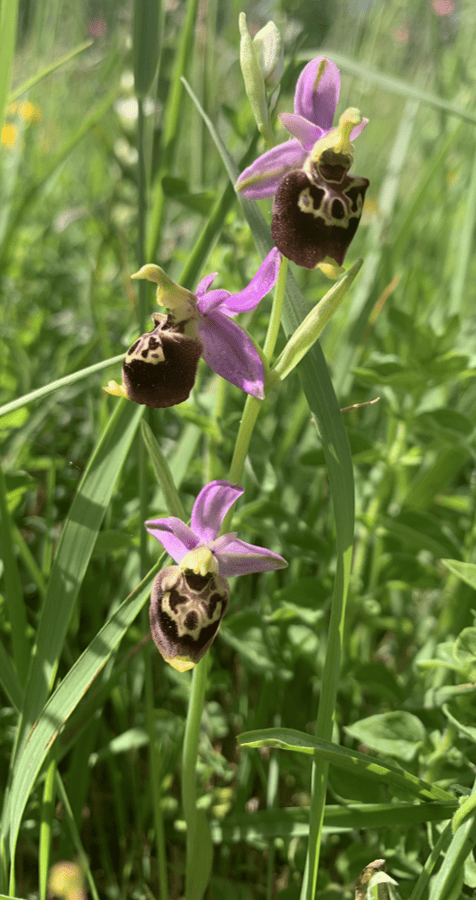
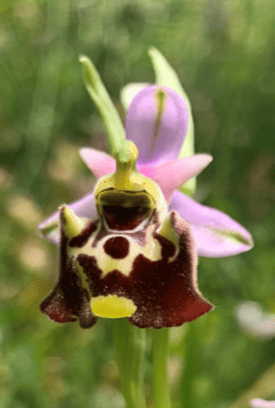
Ophrys holosericea
Etymology: holosericea derives from the greek holos-e (all) and serikos (silk), due to the velvety appearance of the labellum.
Description: This species is characterized by its high morphological variability which has led many authors to describe different infraspecific entities. Plant up to 40 cm high. Erect and light green scape. The lower leaves are almost all united to form a basal rosette, and the upper leaves are enveloping the scape.
The spike-like inflorescence may consist of 2 to 10 flowers. Sepals are ovate and may be white, pink, or purplish red with green veins. Petals are subtriangular, pink, or purplish red and rarely white. Lip downwards, velvety with brownish marginal hairiness with more or less evident basal gibbosity. The speculum is very variable in shape, brownish-red in colour with white or yellow margins. Apicle is very developed facing forward and yellowish-green above. Gynostemium is short and acute.
Ophrys fusca sub. Lucana
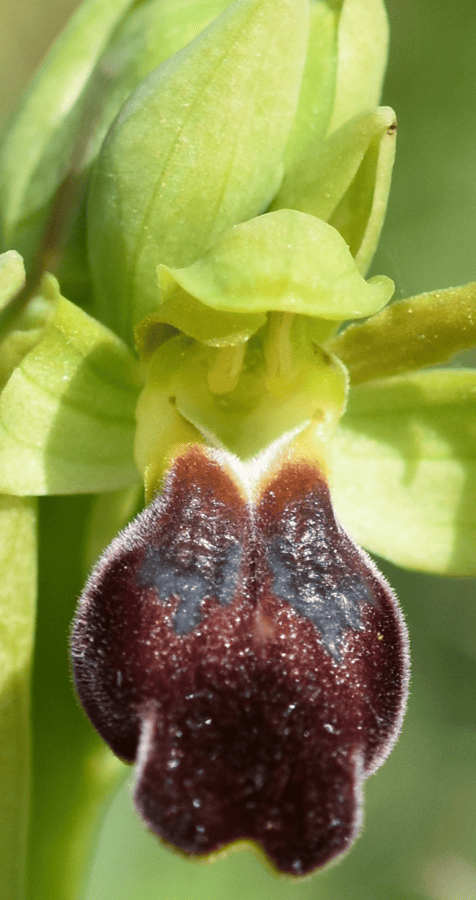
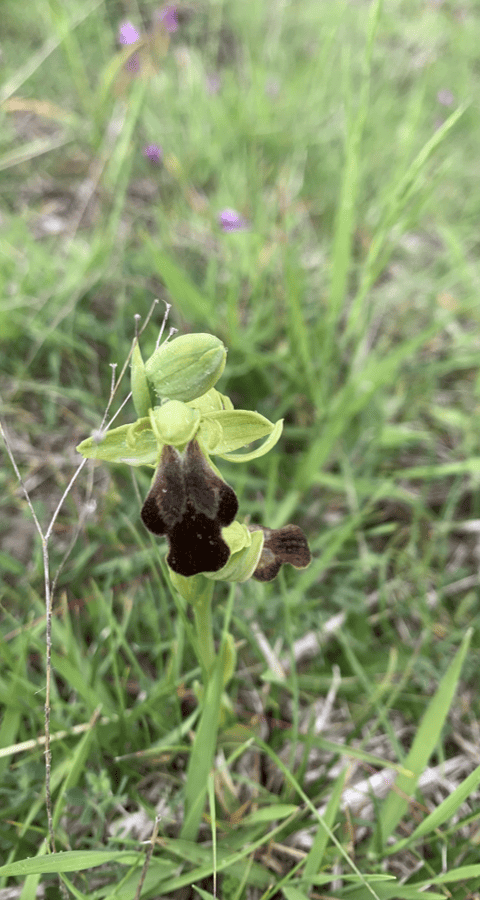
Ophrys fusca sub. Lucana
Etymology: the epithet fusca derives from the latin fuscus (dark), due to the dark colour of the labellum. The name lucana, on the other hand, is linked to the name of the place where it was first sighted in Basilicata.
Description: plant up to 25 cm high. Stem thin, light green. The lower leaves, oblong-lanceolate, are arranged in a basal rosette. Inflorescence dense and may have 2 to 8 flowers.
The flowers are large and dark. Tepals are yellowish-green in colour, and the middle one is curved on the gynostemium. Lip brown, and velvety with a distinct yellow edge. Speculum covers about two-thirds of the entire lip and is metallic grey in colour and rust red towards the base; the stigmatic cavity is also characterized by whitish hairiness.
Ophrys sphegodes
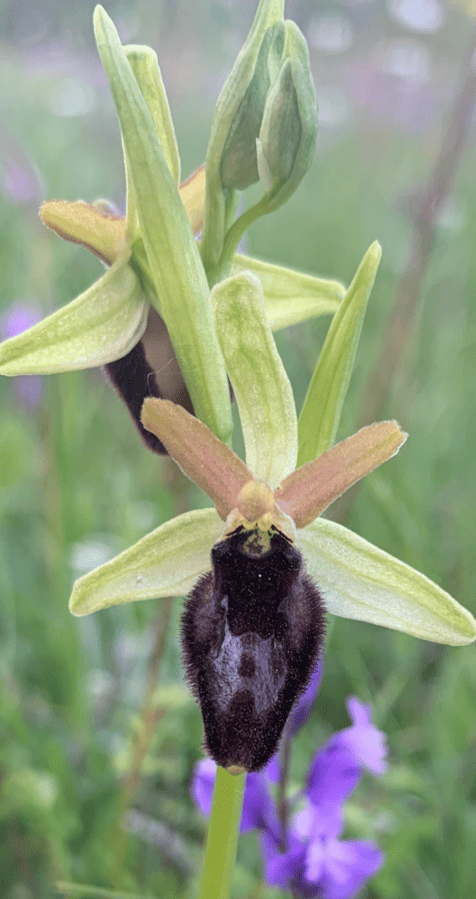
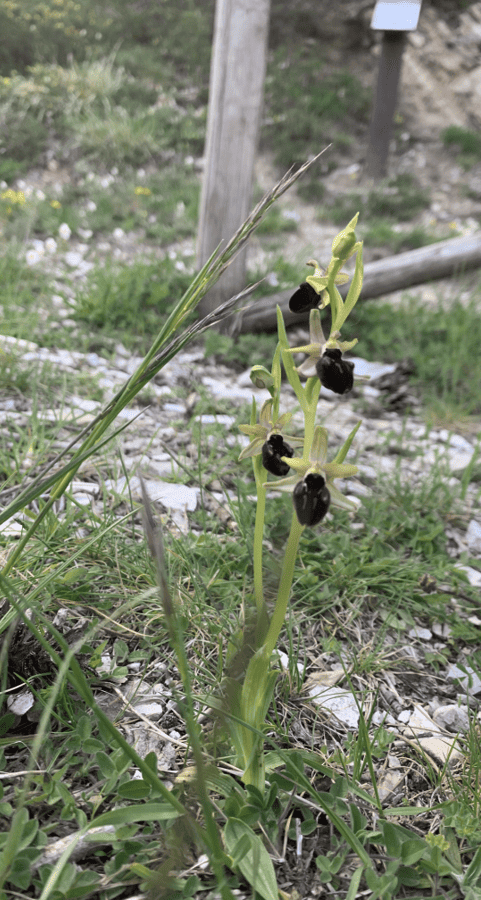
Ophrys sphegodes
Etymology: the epithet sphegodes comes from the greek sphekos, meaning wasp-like.
Description: plant up to 55 cm high. Slender green scape. The lower leaves are clustered to form a light green basal rosette, and the upper leaves wrap around the stem. The inflorescence may consist of 2 to 15 flowers. Sepals green, the middle one slightly forward-facing; the petals are smaller with slightly pinkish, wavy margins. The lip is large and downward-facing, highly variable in shape and colour, with marginal hairiness. The margin is often bordered by a yellow line. It has a brownish or dark blue H-shaped speculum. Greenish and very conspicuous gynostemium.
Orchis purpurea
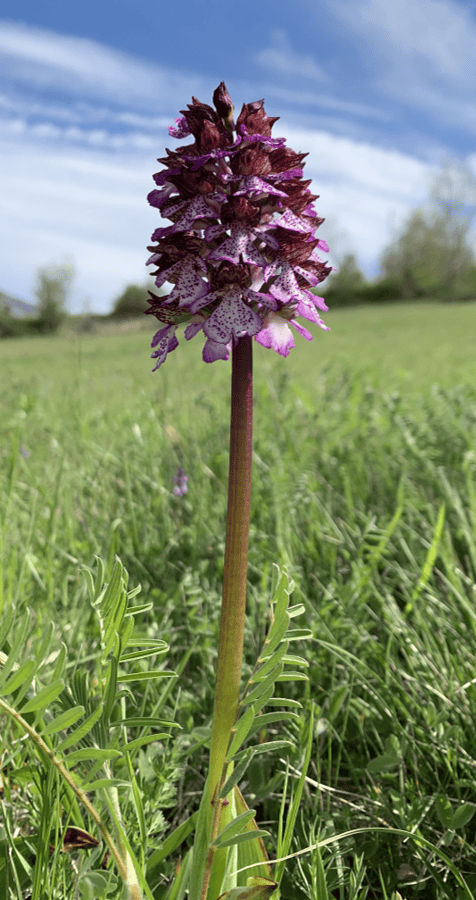
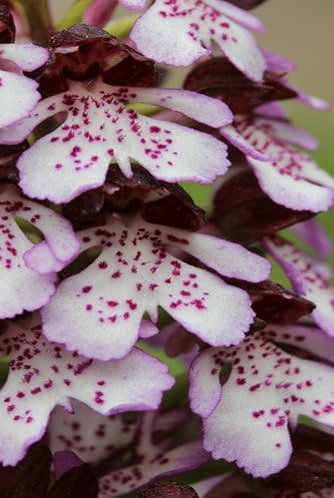
Orchis purpurea
Etymology: The epithet purpurea comes from the latin purpureus-a (purple) given the colour of some parts of the flower.
Description: plant up to 80 cm high. Robust, cylindrical scape green at the base and tinged with purple at the apex. Large, oblong, glossy green lower leaves are arranged in a basal rosette, the upper leaves wrap around the stem. Dense inflorescence with large purple-pink flowers. Sepals and petals are united to form a helmet on the greenish lip with obvious purple streaks and maculae. The lip is 3-lobed with a white or shaded pink background with conspicuous purple maculae and purple margins. Spur not longer than the ovary, curved downwards and obtuse gynostemium.
Platanthera bifolia
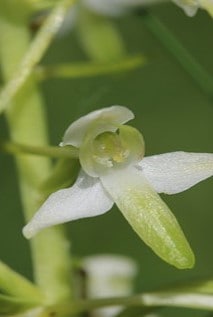
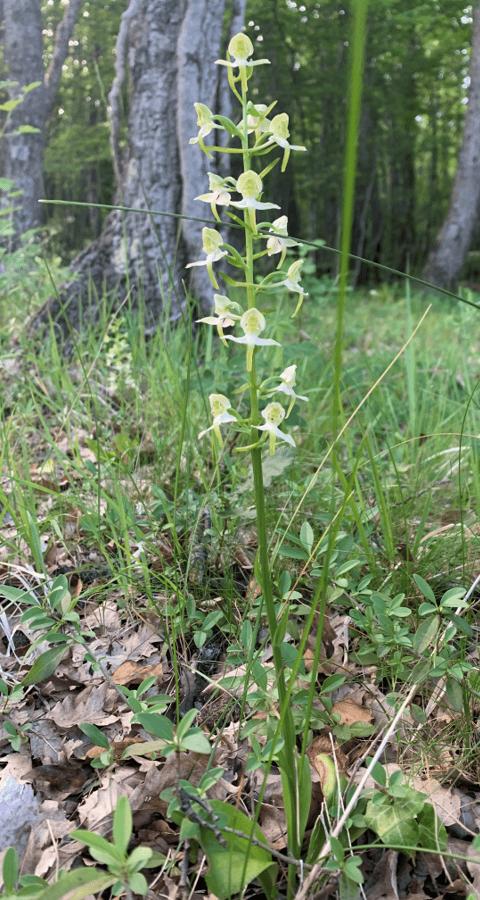
Platanthera bifolia
Etymology: the epithet bifolia comes from the latin word meaning two leaves because this plant has two large leaves at the base.
Description: plant up to 50 cm high. The scape is slender and light green in colour. The leaves at the base are large, oblong-lanceolate and glossy. The slender, cylindrical multi-flowered inflorescence may consist of up to 40 very fragrant flowers. The tepals are white slightly tinged with green. The median tepal is shorter than the others folded forward. The lip is pendulous, and white with the tip shaded green. The nectar spur is long, slender and longer than the ovary.
Serapias vomeracea
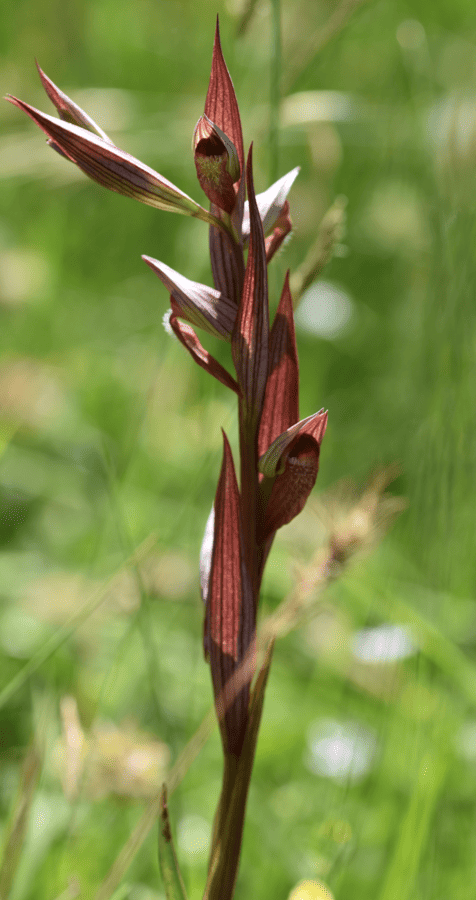
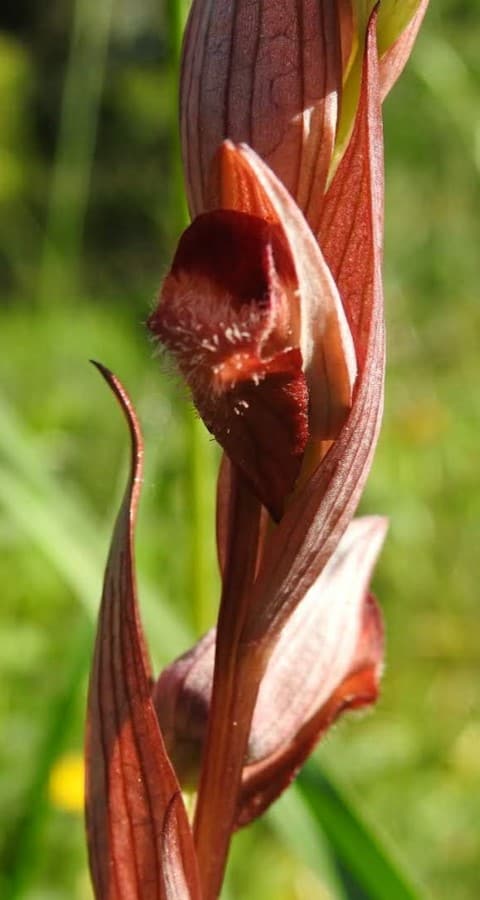
Serapias vomeracea
Etymology: the epithet vomeracea derives from the latin vomer (vomere) from the shape of the labellum in the distal part that resembles a ploughshare.
Description: plant up to 55 cm high. Scape robust, purplish-coloured. Leaves bluish-green sheathing lanceolate and arcuate, the basal ones in a rosette with sheath often streaked in purplish red. Inflorescence lax and elongated to slender and threadlike, 3 to 12 flowers. Sepals red internally, grey externally, with purplish stripes; petals are red-black. The lip is brownish-red and 3-lobed, much exceeding the sepals. The middle lobe is narrow and sprinkled with hairs sometimes with a lighter area in the centre; the prominent median lobe is triangular; the bracts are longer than the cap. Lateral lobes very dark, concealed between the tepals. White flowers are rare. Spur absent.

